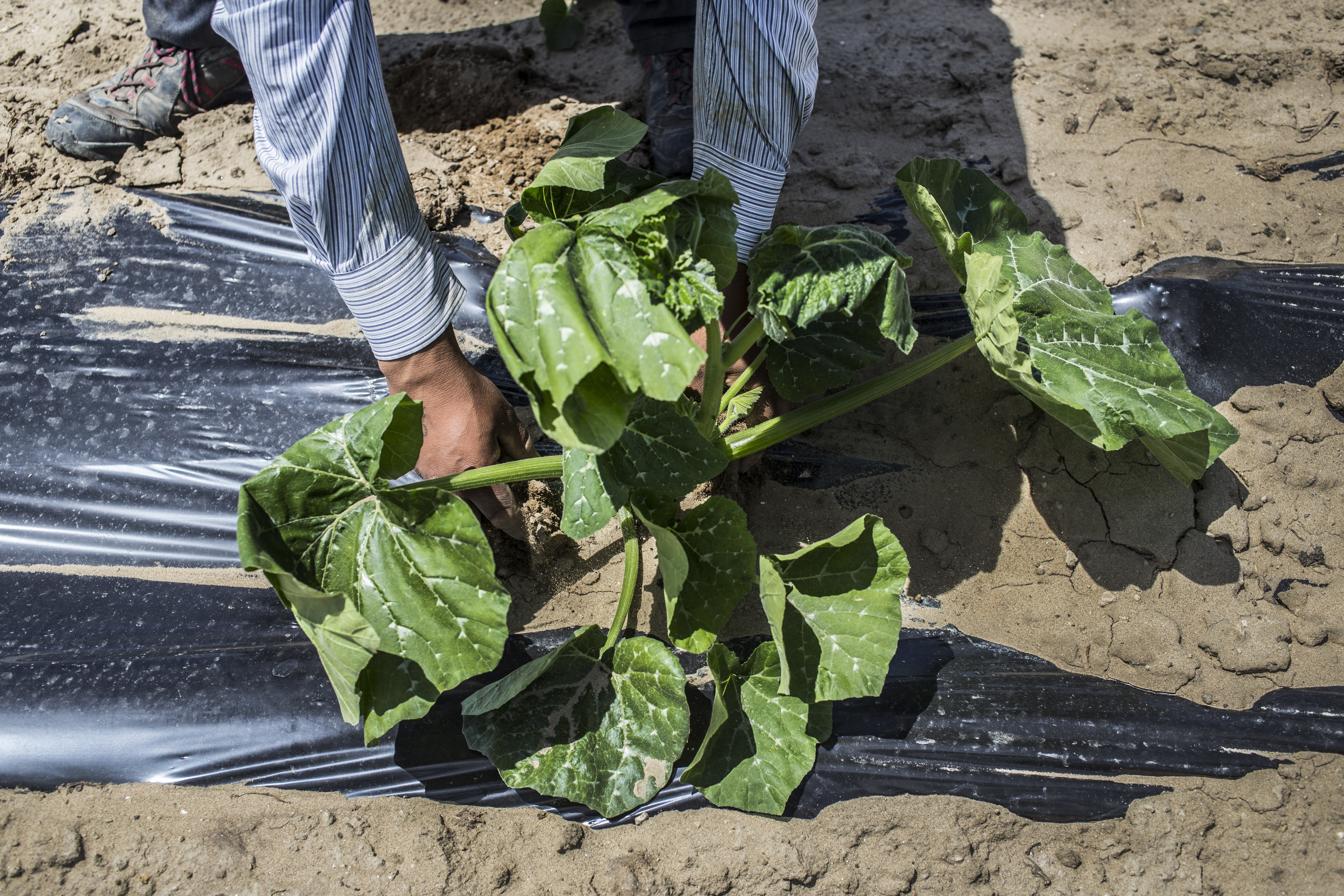The global landscape is rapidly changing and the world faces an uphill challenge of ensuring food supply for everyone on the planet today and in the future. Increasing global food production in a sustainable manner will be possible only if a complex set of factors are taken into account, putting soil health management first – an objective that can be achieved only with a balanced and rational use of fertilizers and organic farming.
Agricultural intensification has been a key factor in boosting global food production in the past 50 years and has kept up with rapid population growth. The global per capita food supply has increased rapidly, with yield per hectare nearly doubled in a 20-year period. This remarkable achievement in food production has contributed to hunger reduction and improved nutrition and has been primarily the result of technological advancements and increased inputs—fertilizer, water, pesticides, drugs, new crop varieties, and high-producing livestock breeds, a clear legacy of the Green Revolution.
Nonetheless, the increase in production alone has not been sufficient to eradicate hunger, as one out of eight people in developing countries still suffers from chronic hunger, largely in Africa and Asia. According to latest estimate by FAO (2017), global hunger has risen by 38 million—the number of chronically food-insecure and malnourished people increased from 777 million in 2015 to 815 million in 2016, From 2013 to 2050, global food production must increase by 50 percent in order to cope with increasing demand for food from population growth. In particular, sub-Saharan Africa and South Asia would need more than double agricultural output to meet increased demand.
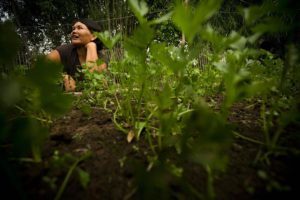
IN THE PHOTO: 22 June 2006, Siem Reap – A Telefood project beneficiary tending to the herb garden that her family keeps. She, her husband and their five children all contribute to the various chores involved with raising animals (pigs and chickens) and gardening. PHOTO CREDIT: FAO/A.K. Kimoto
The boost in food supply and agricultural technological advancement has at a high cost to the society and the environment.
Among adverse consequences are land degradation, including increasing desertification, soil erosion, soil fertility decline, soil acidification, increasing salinisation and over-extracted groundwater in irrigated lands, pollution of groundwater and watersheds—resulting in human and environmental health impacts, and climate change due to greenhouse gas emissions from fertilizer and fossil fuel for machines.
The ability of the world to feed itself will be threatened unless there is a deliberate effort to restore, conserve and manage the existing agro-ecosystems in a sustainable way. This challenge is enormous and multifaceted, considering that the global soil health is already overstretched, and further exacerbated by the increasing threats posed by climate change.
The case for production sustainable intensification
There is growing concern about whether agriculture can sustainably meet future demand given two opposing trends: a rising population and diminishing natural resources, exacerbated by climate change. As volatile climatic patterns increase, competition for land and water will intensify.
Pressure to enhance our current food production systems is mounting – to make them more productive while reducing environmental degradation and addressing climate change.
The case for agricultural production intensification in the 21st century is generally based on two premises:
1) The world needs to produce more food to feed the growing global population;
2) The available arable land cannot be expanded without compromising the planet’s resources through more deforestation and leading to environmental footprints.
Therefore, increasing food production without expansion of agricultural lands warrants that we must increase production on the existing agricultural lands. Unfortunately, the need to increase production is also the argument for justifying high-input, industrial-oriented monoculture model, with inadequate consideration to the impact on the environment and the socioeconomic dimensions of sustainability. Intensification alone without concern for sustainability is counterproductive.
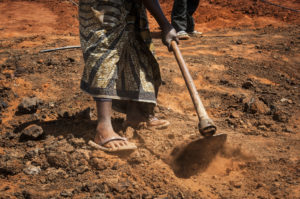
IN THE PHOTO: 12 December 2013, Gawaye Grape Farm Project, Dodoma, Tanzania – A small scale farmer preparing trench excavation and fertilization on the 300-acre grape production project. PHOTO CREDIT: FAO/IFAD/WFP/Eliza Deacon
Yield gaps for major crops including cereals, roots and tubers, pulses, sugar crops, oil crops and vegetables, generally exceeds 50 percent across regions, ranging from 11 percent in East Asia to 76 percent in sub-Saharan Africa (FAO, 2016).
This reflects sub-optimal use of inputs and insufficient adoption of technically productive technologies. It can also create opportunity for increasing productivity in a sustainable way.
Organic VS inorganic fertiliser debate
Unfortunately, the debate on sustainable soil fertility management is often polarised, with one camp advocating for pure organic farming and prohibition of fertiliser use. The advocates of this view argue that mineral fertilisers are always harmful to both the soil and human health. The second camp argues that high-input inorganic fertilisation is the only way to address the worsening soil fertility problem. Both positions are on the extreme and are rarely helpful to the fight against hunger and malnutrition.
In fact, food production based on 100 percent organic inputs does not necessarily imply a good soil health management and may not always ensure long-term sustainability. For instance, a production system that does not create income, address social aspect and contribute to improving the livelihood needs of the producer cannot be considered sustainable.
Simply relying on organic nutrient source can equally be counterproductive, especially when essential nutrients (macro- and micro-nutrients) removed in each harvest over several seasons, but are not returned back to the soil. In the long-term, practices such zero fertiliser input system is tantamount to “nutrient mining” from the soil and may lead to imbalance of both macro and/or micronutrients. Nutrient imbalance and micronutrients deficiency can reduce yield and have implications on the nutrition of consumers. On the other hand, research has also showed that heavy use of mineral fertilisers have their negative consequences, including soil acidification, ground water pollution, green-house-gas emissions and other effects. Long-term yield decline over time is inevitable even with the same level of fertiliser dose. There is need for balance.
Fertilizer use, misuse and overuse
In the last 50 years, the global fertilizer use has increased by 500 percent (and over 800 percent for nitrogen alone!). The world fertilizer nutrient (N+P2O5 +K2O) consumption has increased from 162 million tonnes in 2008 and is projected to reach 201 million tonnes in 2018, at annual growth rate of 1.8 percent per (FAO, 2015). Overall, mineral fertilizers has resulted in over 40 percent of the increase in food production. This is due to the fact that, nitrogen availability is the most important determinant of yield in most major crops. However, several environmental problems are associated to the input-intensive monoculture-led, industrial and commodity-based agriculture model that now dominate food production.
Excessive use of chemical fertilisers, specifically phosphorus and potassium, which have to be mined from reserves held in rocks and minerals, poses major threats to future food security. The high-energy required for production of synthetic fertilisers make agriculture and soil fertility, in particular, over-dependent on the oil price.
Nitrogen use efficiency (NUE) is generally low, usually less than 50 percent and averaging 33 percent globally. More of concern it that the NUE is also declining, from 80 percent in 1960 to 30 percent in 2000. Approximately 67 percent of N applied to crops are uncounted for in form of N loss through gaseous emissions, soil leaching, surface run-off, as well as through volatilisation and denitrification. This has been estimated to 15 billion annual loss of N fertiliser. As a result, farmers have to apply far more N fertiliser than is needed, and most of it is wasted.
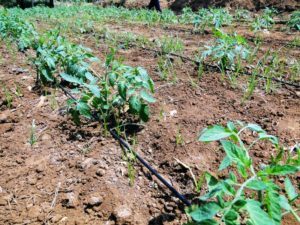
IN THE PHOTO: 19 July 2012, Katse – Furrow irrigation implemented in a small-scale tomato farm. FAO, in partnership with other organisations has been promoting the use of modern irrigation methods to foster improved nutrition and ensure food security in Arid and Semi-Arid Lands (ASALs). PHOTO CREDIT: FAO/Eric Kimani.
The widespread use of chemical fertilisers and pesticides, are also threatening crops that are dependent on pollination may affect human health negatively. Nitrate levels in water in excess of the upper limit of 50 mg/litre set by the World Health Organization (WHO) are likely to pose health hazards. Fertilizer contamination also poses the danger of eutrophication of lakes, rivers, and coastal waters, with damaging consequences on aquatic ecosystems. Much of the chemical fertilizers applied to the soil, especially nitrogen, are leached and can easily become pollutants to the underground water. It is estimated that some countries could actually halve the use of nitrogen without negatively affecting the yield.
Maintaining soil health
Soils are fundamental for the production of food, crops, feed, fibre, fuels and many essential ecosystem services, and regulates water resources and climate. Most of global human food production depends on the soil. Farming practices through the ages have led to accelerated soil fertility depletion through erosion and nutrient removal. Scientists have warned that modern agriculture is increasingly transforming the planet and is gradually throwing the soil’s cycle out of balance.
Recent studies show that about 33 percent of global soils and more than half of agricultural soils are moderately or highly degraded due to unsustainable management practices.
On a global scale, an annual loss of 75 billion tons of soil from arable land is estimated to cost about USD 400 billion each year in lost agricultural production (FAO, 2017). Soil is the world’s major storehouse for carbon, which also helps to regulate CO2 emissions and other greenhouse gases. Soil organic matter is the principal sources of other nutrients. It is a good indication of good soil health, and crop response to fertilisers. In general, soil organic matter levels are declining and the use of chemical inputs is intensifying. The widespread use of synthetic fertilisers has altered C, N and P cycles at the global scale. Such intensified and widespread use of high amount of fertilisers also has far-reaching effects on the environment. A historical global C loss due to agricultural activities has been estimated at 55–100 Pg from soil C pool, and 100 to 150 Pg from the biotic C pool. There is need to promote sustainable soil management practices that can build up the soil organic carbon capital. Although often being overlooked by policy makers, soil carbon sequestration can make a major contribution to mitigating climate change.
Synthetic fertilisers seem to encourage farmers to move away from the more agroecological, knowledge-based and labour-intensive soil fertility management practices, and may have incentivised them to specialise on only a few crops at the expense of developing the vast biodiversity of species available for human food security and nutrition.
Nonetheless, a judicious use of chemical fertilisers can create the necessary synergistic effect when combined with organic nutrient sources. For instance, nitrogen is the most abundant element in the atmosphere (78 percent), this can be harnessed for crop’s use through biological N fixation by leguminous species and integrated soil fertility management systems, such as the fertiliser trees and Evergreen agriculture practices (Akinnifesi et al, 2010; Garrity et al, 2010). The future of sustainable agriculture is through integrated nutrient management that ensures soil health and increased productivity. We need to find the right balance on intensification that reduces use of chemicals, reduce soil compaction and maintain soil health.
Soil erosion also has a direct link to declining soil fertility. It is estimated that half of the world’s top soil has been lost in the last 150 years due to erosion. Fertiliser application cannot prevent soil erosion, but agroecological soil health management systems can.

IN THE PHOTO: Preparation of soil before planting rice seedlings on terraced hillsides. PHOTO CREDIT: FAO/Antonello Proto
The crucial role of soil biodiversity
Agricultural sustainability requires effective management of the soil, water and crop. The soil is the planet’s most biologically diverse ecosystem. Soil biodiversity plays a central role in maintaining soil organic matter, soil fertility and soil health dynamics. Recent studies have shown that microbial diversity can explain 77 percent of carbon mineralisation activities, indicating the importance of soil microbes’ diversity, including soil micro fauna. These soil micro and macro fauna improve soil physicochemical properties through the decomposing of organic residues, soil aeration, and storage of water, reduce erosion, break down of organic matter and increase plant nutrition. Soil biodiversity can also suppress disease-causing soil organisms, soil-borne plant pathogens, thereby contributing to production of healthy crops. Sustainable soil management practices that conserve the ecological processes, reduce the use of external inputs and their negative environmental impacts should be promoted and scaled up.
Looking into the future
This article advocates a transformative change in agricultural production and food systems in both developing and developed countries. Below are a few key elements that can guide a global strategy and policy that will help to sustainably produce food and address the declining soil fertility problem.
- Strengthen productivity of small-scale agriculture. When many think of agriculture for food security, the picture that comes to mind is that of an industrial scale, monoculture, heavy inputs and efficient systems to produce food massively and cheaply for everyone. Whereas, the world food supply mainly comes from over 500 million small holder and family farmers cultivating less than 2 hectares on 12 percent of the world’s agricultural land, especially in Africa and Asia. About 70 percent of the food calories come from these small farms! While excessive use of mineral fertilisers and nutrients constitute a major problem for industrial agriculture in some regions (e.g. Asia), the sub-optimal fertiliser use is a major problem in some regions, especially sub-Saharan Africa. Therefore, improving the efficiency of resources use on small farms and low-input production systems could go a long way to meet global supply needs.
- Promote agroecological approaches to soil health. Agroecology represents a paradigm shift from ‘a ready-to-use’ blanket approach to environmentally customised production systems. The production systems required to sustainably manage the soil fertility, biodiversity and soil health, conserve and make more efficient use of the natural resources, will vary depending on the local conditions and needs. The future of agriculture is clearly not “input-intensification” but “investment in knowledge-intensive and sustainable systems”. This requires a combination of responses. However, I would like to caution that this should not be interpreted as a simply a “back to the future” concept, advocating a return to the original farming without use of fertilisers or pesticides, nor a promotion of pure organic farming. Rather, there is a need to promote a vision of sustainable agriculture that ensures improved soil productivity and soil health, and reduced and more efficient use of inputs, with conscious effort to conserve the natural resources base. This warrants an integrated approach and combination of responses, as there is no magic bullet. No single approach or technology can provide all the solutions for specific soil fertility constraints that prevail in different locations.
This requires putting agroecological innovations to practice, in a way that combines the nutrients that are available in nature with inorganic supplement. These will help reduce fossil fuels and cut on the cost and requirement of chemical fertilisers. Nonetheless, fertilisers are still crucial for smallholder farmers to achieve higher yields of crops, what is unnecessary is the high rate of fertiliser use. The future of agriculture will depend on a healthy balance of combining mineral fertilisers with organic, mainly biological nutrient sources.
- Embrace an integrated and holistic approach to sustainability. FAO launched the Save and Grow initiative as a new paradigm for sustainable and intensive crop production that would enhance both productivity and sustainability. It is a policy maker’s guide on sustainable smallholder crop intensification. Sustainable crop production intensification aims at producing more from the same area of land and other natural resources while conserving resources, reducing negative inputs on the environment and enhancing natural capital and the flow of ecosystem services.
In order for food and agricultural systems to be sustainable, they must equally and simultaneously address the social, economic and environmental dimensions—the three bottom-line. Neglecting any one aspect jeopardises the attainment of sustainability in the other dimensions. In this regard, FAO has developed a common vision for sustainable food and agriculture that can collectively guide the process of transition to sustainable agriculture (FAO, 2014). This involves five interconnected principles aiming at
i) improving efficiency in the use of resources is crucial to sustainable agriculture;
ii) direct actions to conserve, protect and enhance natural resources;
iii) protecting and improving rural livelihoods and social well-being;
iv) enhancing resilience of people, communities and ecosystem;
v) ensuring responsible and effective responsive governance.
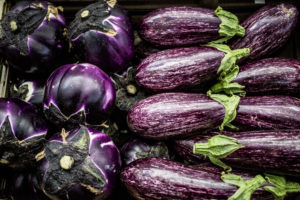
IN THE PHOTO: 14 June 2016, Fiumicino, Italy – Partecipants of Global Alliance for Climate-Smart Agriculture (GACSA) Annual Forum, held at FAO Headquarters attend a field visit to Orto Sole cooperative farm in Fiumicino and Torrimpietra. PHOTO CREDIT: FAO/Alessandra Benedetti
Concluding remarks
The challenge for producing enough food is not just that of intensification but how to ensure sustainability of agricultural production systems; otherwise it will be tantamount to mortgaging the resources needed by the future generation in order to meet the current needs.
Soil fertility depletion cannot be addressed simply by pumping more and more chemical fertilisers to the soils. Efforts that reduce the use of chemical fertilisers without compromising soil productivity, maintaining the natural resource base and human health, is the future of agriculture.
There is great urgency and perils of deferment as we transition to a more sustainable agriculture. Food and nutrition security strategies must ensure that the soil is healthy to produce healthy plant, nutritious diet and human health. This requires viewing the crop production with the lens of soil health, nutrition and with sustainability perspective, within the wider context of food systems.
NOTE: THE OPINIONS EXPRESSED HERE BY IMPAKTER.COM COLUMNISTS ARE THEIR OWN, NOT THOSE OF IMPAKTER.COM.
FEATURED PHOTO CREDIT: FAO/Alessandra Benedetti


